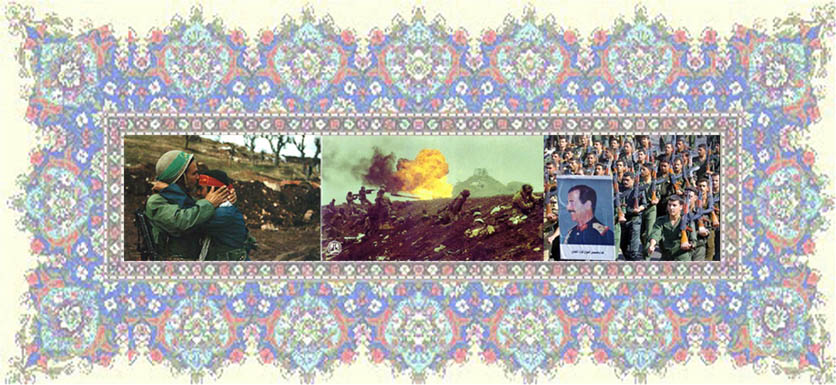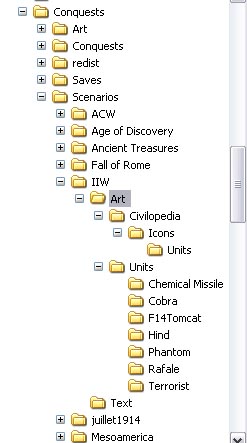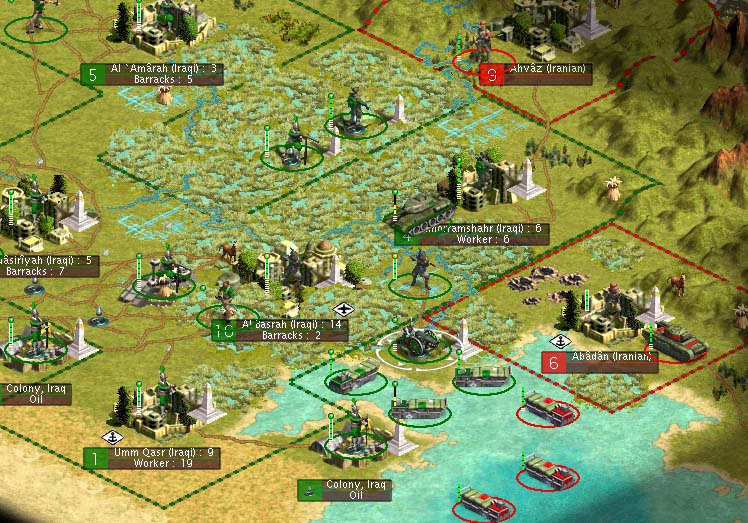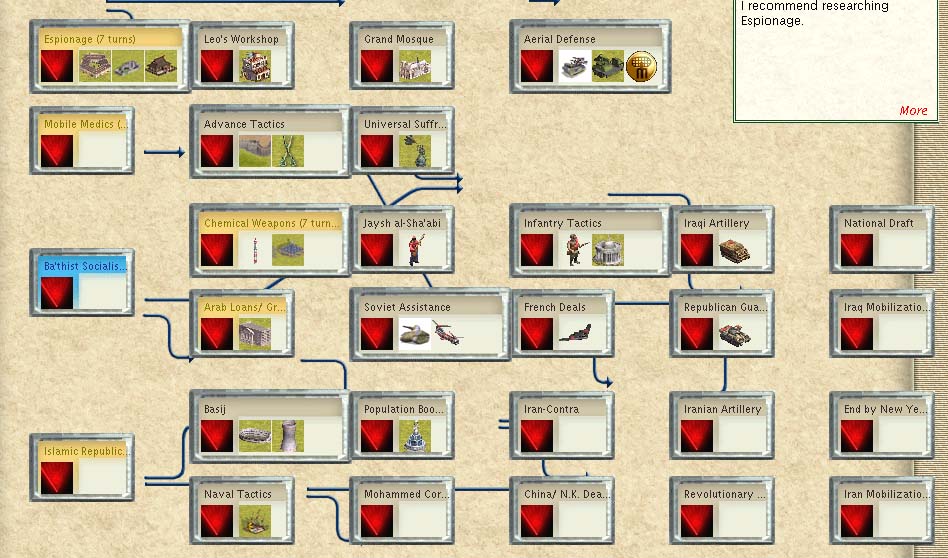Mr Black
Los Zetas
INTRODUCTION
Conquest ONLY!!!

The border between Iraq and Iran has been contested diplomatically and sometimes militarily for several centuries. After the Ottoman Empire conquered present-day Iraq in 1534, making it the easternmost part of its empire, Iran, its eastern neighbor, became a frequent rival. More recently, when Iraq was made a separate state in the aftermath of World War I (1914-1918), Iraq and Iran disagreed sharply over the precise border between them, especially in the area of the Shatt al Arab, a river channel providing Iraq's only outlet to the sea, via the Persian Gulf. In 1937 the two sides came to an agreement establishing a boundary that gave Iraq control of the Shatt al Arab.
Despite the border agreement, relations between Iran and Iraq continued to suffer periodic crises for two reasons. First, although Iraq is predominantly Arab and Iran is predominantly Persian, the border still cut across some political loyalties. In the north, a large population of Kurds (who are neither Arab nor Persian) straddled both sides of the border. Along the southern part of the border, an Arab minority inhabited the Iranian province of Khûzestân among a Persian majority. Furthermore, the largest portion of the Iraqi population is Shia Muslim, as is the majority of the Iranian population. Shia religious leaders at odds with the secular (nonreligious) government of their own country sometimes sought refuge in the other, straining Iranian-Iraqi relations. The most prominent refugee was Ayatollah Ruhollah Khomeini, a leading Shia religious scholar who settled in Iraq after being exiled from Iran in 1964.
The second reason Iran and Iraq continued to suffer crises was that both countries were politically unstable. When either Iran or Iraq experienced a revolution or coup, the other country would exploit the troubled countrys political weakness to gain a diplomatic advantage. As Western countries, especially the United Kingdom, gradually lost influence in the area in the mid-20th century, both Iran and Iraq felt freer to pursue more ambitious foreign policies, unhindered (and at times even supported) by external powers. By the beginning of the 1970s both Iran and Iraq sought broader influence in the region. Under Muhammad Reza Shah Pahlavi, Iran felt it could assert its authority in the area, partly with the backing of the United States. Iraq, governed by the Arab nationalist regime of Major General Ahmed Hassan al-Bakr, sought to unite and strengthen the Arab world and reject Western influence. These opposing views created a bitter rivalry between the neighboring countries.
In the early 1970s Iraq's Kurdish population rebelled against the country's government, and Iran joined several other countries in supporting the insurgency. At peace talks in Algiers, Algeria, in 1975, Iran agreed to abandon its support for the Kurdish rebellion in return for an agreement by Iraq to share the Shatt al Arab waterway with Iran. Thereafter, the border between Iran and Iraq was drawn down the middle of the Shatt al Arab rather than along its eastern (Iranian) bank as agreed in 1937.
In January 1979 followers of Ayatollah Khomeini led a revolution that toppled the shah. The following month, Khomeini returned to Iran and began to take control of the new government. In April, after a popular referendum, Khomeini declared the establishment of an Islamic republic. The revolution posed what seemed to be both an enormous opportunity and a dire threat to the Iraqi government, now under the control of Saddam Hussein. On the one hand, Iran was in disarray. The various elements in the coalition that overthrew the shah were badly divided and the army was being purged. Further, the taking of American hostages in November 1979, combined with the desire of the new government to free the country from all foreign influence, left Iran internationally isolated. Never had Iraqs rival been so vulnerable.
On the other hand, Iranian Shia Muslims had carried out the successful revolution against the shahs secular government. Their success excited many Iraqi Shias with the possibility of similar gains in their country. Although Shias also constitute the majority of Muslims in Iraq, the Sunnis (Sunni Islam) had long held political power in Iraqs secular government. Cautiously, the domestic opposition to Husseins strong-handed government became emboldened. One Iraqi religious leader in particular, Muhammad Baqir al-Sadr, emerged with ideas very similar to Khomeinis. Al-Sadr was soon arrested and executed, bringing protests from some Iraqi Shias as well as a crisis in Iranian-Iraqi relations.
While these events were unfolding, some Iranian officials made no secret of their desire to have other Muslim countries follow their path of Islamic revolution. A crisis between Iran and Iraq escalated during 1980 as the two countries accused each other of border violations and interfering in each others internal affairs. Iraq responded to the escalation by repudiating the 1975 agreement giving Iran access to the Shatt al Arab in September 1980. Several days later, on September 22, Iraq launched a full-scale invasion of Iran.
© 1993-2003 Microsoft Corporation. All rights reserved.
The Iraqis invaded Iran on September 22, 1980. Their major thrust was directed at Irans
Khuzestan province, in the extreme southernmost portion of the country, on the northern Gulf. Concurrently, two smaller penetrations occurred in areas farther north along the border.
Iraq committed 7 of its 12 divisions to the invasion, 5 of them entering Khuzestan. The objective of the latter was to seize four citiesKhoramshahr, Abadan, Dezful and Ahvaz. This would enable the Iraqis to cut off the main reinforcement route to the province from Tehran, and would deliver the Shatt Al Arab into their hands.
Military experts predicted the war would end in three weeks, it lasted 8 years.
--------------------------------------------------------------------------------------
For more information about the Iran-Iraq War please look at this thread.
Additional Information
There you will find other links and information. Thanks to yaroslav, Case, pawpaw, jroa99
--------------------------------------------------------------------------------------
CREDITS, ACKNOWLEDGEMENTS: All of these people helped create the Iran-Iraq War Scenario. And I am forever grateful to them.
------------------------------------------------------------------
Pawel from Sweden
The Last Conformist a native of Sweden
TRpwau from Americas Playground (Atlantic City)
tossi from Europe (Germany)
Zeeketer from Belgium
Ekmek from the Empire of California
-----------------------------------------------------------------------------
Download the Iran-Iraq War scenario here. Install Instructions on the next post. This is version 0.5
Download FULL SCENARIO: IIW-version0.5 HERE (1.3 Mb)
Included in this download is;
3 .biq files: IIW-MPv05, IIW-Iranv05, IIW-Iraqv05
Civilopedia Icons, units32, terrain
3 new unit folders:
shershen - created by Wyrmshadow
osa - created by Wyrmshadow
nanuchka - created by Wyrmshadow
PediaIcons.txt, Civilopedia.txt and ReadME files, among other folders.
There are three versions of the scenario in here. Reasons why are explained in the 3rd post.
Additional Units Here If you previously downloaded the IIW scenario, you dont really need these units. But if you replace the entire IIW with the new download above, make sure to move the current units somewhere safe, to later drop them back in. Or, you could just download the units again, if your not too familiar with all that.
Download FULL SCENARIO: IIW-version0.5 Additional Units HERE (2.8 Mb)
Included in this download are unit folders for:
Chemical Missile Gas FLC created by Smoking mirror, sounds created by Vuldacon
Hind - created by Wyrmshadow
Cobra - created by Wyrmshadow
Terrorist - created by Dark Sheer (I think)
Phantom - created by Wyrmshadow
F-14 Tomcat - created by BeBro
Rafale - created by BeBro
If upgrading from v0.4 to v0.5, then all you need is the BIC files.
UPGRADE SCENARIO: IIW-version0.5 HERE (129 Kb)
WWII Units
There are three more units you need to have and theyre from the PTW Extras folder. They are designed by Firaxis. Download them from the Civ3.com website, or from LouLongs thread in the Unit Graphics forum, if you havent done so already.
Italian Rifleman
T-34
Churchill
Conquest ONLY!!!

The border between Iraq and Iran has been contested diplomatically and sometimes militarily for several centuries. After the Ottoman Empire conquered present-day Iraq in 1534, making it the easternmost part of its empire, Iran, its eastern neighbor, became a frequent rival. More recently, when Iraq was made a separate state in the aftermath of World War I (1914-1918), Iraq and Iran disagreed sharply over the precise border between them, especially in the area of the Shatt al Arab, a river channel providing Iraq's only outlet to the sea, via the Persian Gulf. In 1937 the two sides came to an agreement establishing a boundary that gave Iraq control of the Shatt al Arab.
Despite the border agreement, relations between Iran and Iraq continued to suffer periodic crises for two reasons. First, although Iraq is predominantly Arab and Iran is predominantly Persian, the border still cut across some political loyalties. In the north, a large population of Kurds (who are neither Arab nor Persian) straddled both sides of the border. Along the southern part of the border, an Arab minority inhabited the Iranian province of Khûzestân among a Persian majority. Furthermore, the largest portion of the Iraqi population is Shia Muslim, as is the majority of the Iranian population. Shia religious leaders at odds with the secular (nonreligious) government of their own country sometimes sought refuge in the other, straining Iranian-Iraqi relations. The most prominent refugee was Ayatollah Ruhollah Khomeini, a leading Shia religious scholar who settled in Iraq after being exiled from Iran in 1964.
The second reason Iran and Iraq continued to suffer crises was that both countries were politically unstable. When either Iran or Iraq experienced a revolution or coup, the other country would exploit the troubled countrys political weakness to gain a diplomatic advantage. As Western countries, especially the United Kingdom, gradually lost influence in the area in the mid-20th century, both Iran and Iraq felt freer to pursue more ambitious foreign policies, unhindered (and at times even supported) by external powers. By the beginning of the 1970s both Iran and Iraq sought broader influence in the region. Under Muhammad Reza Shah Pahlavi, Iran felt it could assert its authority in the area, partly with the backing of the United States. Iraq, governed by the Arab nationalist regime of Major General Ahmed Hassan al-Bakr, sought to unite and strengthen the Arab world and reject Western influence. These opposing views created a bitter rivalry between the neighboring countries.
In the early 1970s Iraq's Kurdish population rebelled against the country's government, and Iran joined several other countries in supporting the insurgency. At peace talks in Algiers, Algeria, in 1975, Iran agreed to abandon its support for the Kurdish rebellion in return for an agreement by Iraq to share the Shatt al Arab waterway with Iran. Thereafter, the border between Iran and Iraq was drawn down the middle of the Shatt al Arab rather than along its eastern (Iranian) bank as agreed in 1937.
In January 1979 followers of Ayatollah Khomeini led a revolution that toppled the shah. The following month, Khomeini returned to Iran and began to take control of the new government. In April, after a popular referendum, Khomeini declared the establishment of an Islamic republic. The revolution posed what seemed to be both an enormous opportunity and a dire threat to the Iraqi government, now under the control of Saddam Hussein. On the one hand, Iran was in disarray. The various elements in the coalition that overthrew the shah were badly divided and the army was being purged. Further, the taking of American hostages in November 1979, combined with the desire of the new government to free the country from all foreign influence, left Iran internationally isolated. Never had Iraqs rival been so vulnerable.
On the other hand, Iranian Shia Muslims had carried out the successful revolution against the shahs secular government. Their success excited many Iraqi Shias with the possibility of similar gains in their country. Although Shias also constitute the majority of Muslims in Iraq, the Sunnis (Sunni Islam) had long held political power in Iraqs secular government. Cautiously, the domestic opposition to Husseins strong-handed government became emboldened. One Iraqi religious leader in particular, Muhammad Baqir al-Sadr, emerged with ideas very similar to Khomeinis. Al-Sadr was soon arrested and executed, bringing protests from some Iraqi Shias as well as a crisis in Iranian-Iraqi relations.
While these events were unfolding, some Iranian officials made no secret of their desire to have other Muslim countries follow their path of Islamic revolution. A crisis between Iran and Iraq escalated during 1980 as the two countries accused each other of border violations and interfering in each others internal affairs. Iraq responded to the escalation by repudiating the 1975 agreement giving Iran access to the Shatt al Arab in September 1980. Several days later, on September 22, Iraq launched a full-scale invasion of Iran.
© 1993-2003 Microsoft Corporation. All rights reserved.
The Iraqis invaded Iran on September 22, 1980. Their major thrust was directed at Irans
Khuzestan province, in the extreme southernmost portion of the country, on the northern Gulf. Concurrently, two smaller penetrations occurred in areas farther north along the border.
Iraq committed 7 of its 12 divisions to the invasion, 5 of them entering Khuzestan. The objective of the latter was to seize four citiesKhoramshahr, Abadan, Dezful and Ahvaz. This would enable the Iraqis to cut off the main reinforcement route to the province from Tehran, and would deliver the Shatt Al Arab into their hands.
Military experts predicted the war would end in three weeks, it lasted 8 years.
--------------------------------------------------------------------------------------
For more information about the Iran-Iraq War please look at this thread.
Additional Information
There you will find other links and information. Thanks to yaroslav, Case, pawpaw, jroa99
--------------------------------------------------------------------------------------
CREDITS, ACKNOWLEDGEMENTS: All of these people helped create the Iran-Iraq War Scenario. And I am forever grateful to them.

------------------------------------------------------------------
Pawel from Sweden
The Last Conformist a native of Sweden
TRpwau from Americas Playground (Atlantic City)
tossi from Europe (Germany)
Zeeketer from Belgium
Ekmek from the Empire of California
-----------------------------------------------------------------------------
Download the Iran-Iraq War scenario here. Install Instructions on the next post. This is version 0.5
Download FULL SCENARIO: IIW-version0.5 HERE (1.3 Mb)
Included in this download is;
3 .biq files: IIW-MPv05, IIW-Iranv05, IIW-Iraqv05
Civilopedia Icons, units32, terrain
3 new unit folders:
shershen - created by Wyrmshadow
osa - created by Wyrmshadow
nanuchka - created by Wyrmshadow
PediaIcons.txt, Civilopedia.txt and ReadME files, among other folders.
There are three versions of the scenario in here. Reasons why are explained in the 3rd post.
Additional Units Here If you previously downloaded the IIW scenario, you dont really need these units. But if you replace the entire IIW with the new download above, make sure to move the current units somewhere safe, to later drop them back in. Or, you could just download the units again, if your not too familiar with all that.
Download FULL SCENARIO: IIW-version0.5 Additional Units HERE (2.8 Mb)
Included in this download are unit folders for:
Chemical Missile Gas FLC created by Smoking mirror, sounds created by Vuldacon
Hind - created by Wyrmshadow
Cobra - created by Wyrmshadow
Terrorist - created by Dark Sheer (I think)
Phantom - created by Wyrmshadow
F-14 Tomcat - created by BeBro
Rafale - created by BeBro
If upgrading from v0.4 to v0.5, then all you need is the BIC files.
UPGRADE SCENARIO: IIW-version0.5 HERE (129 Kb)
WWII Units
There are three more units you need to have and theyre from the PTW Extras folder. They are designed by Firaxis. Download them from the Civ3.com website, or from LouLongs thread in the Unit Graphics forum, if you havent done so already.
Italian Rifleman
T-34
Churchill
Last edited by a moderator:






 , but when installing and loading three things came to mind.
, but when installing and loading three things came to mind.![Civ3 Conquests [c3c] [c3c]](/images/smilies/c3c.gif) unit directory to your own, and use some program to paste in the small icons into the sheet. Since you own scenario comes first in the path, this file will be used instead of the default one.
unit directory to your own, and use some program to paste in the small icons into the sheet. Since you own scenario comes first in the path, this file will be used instead of the default one.
